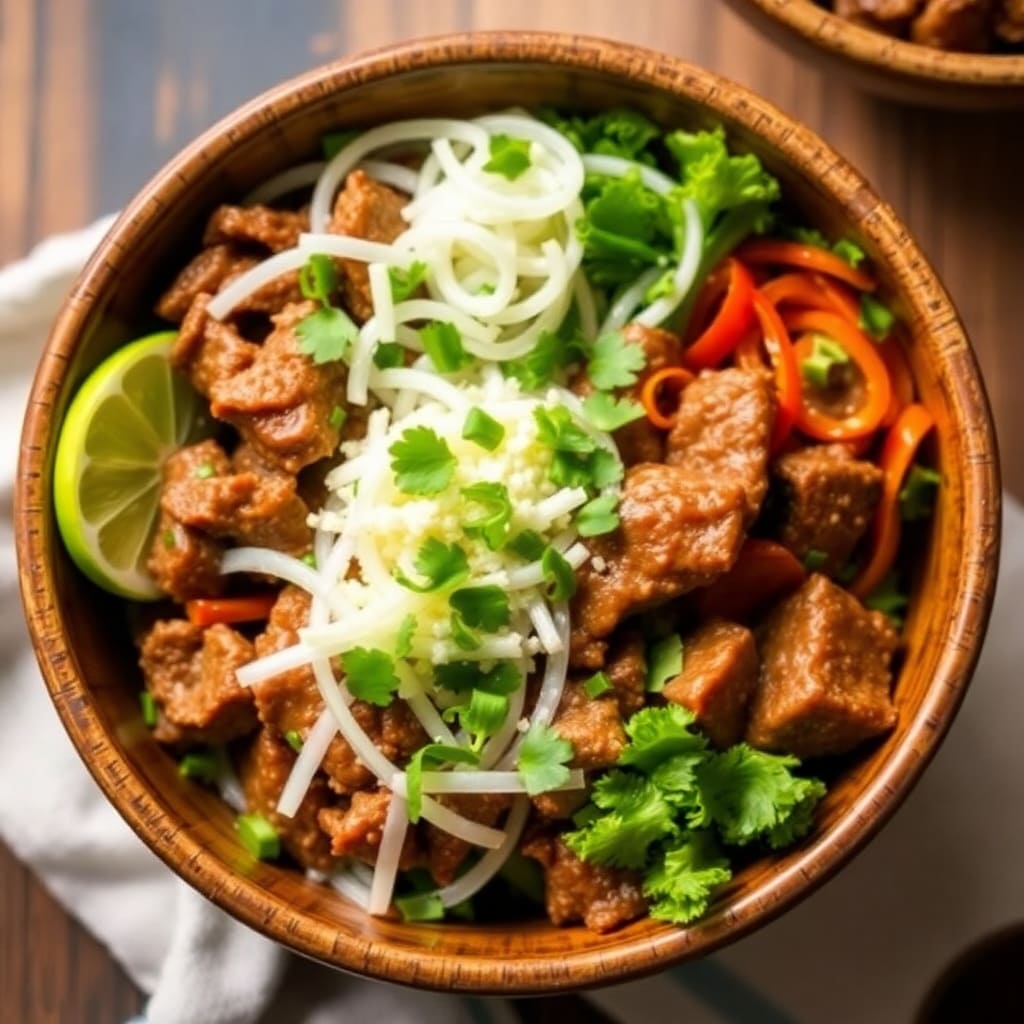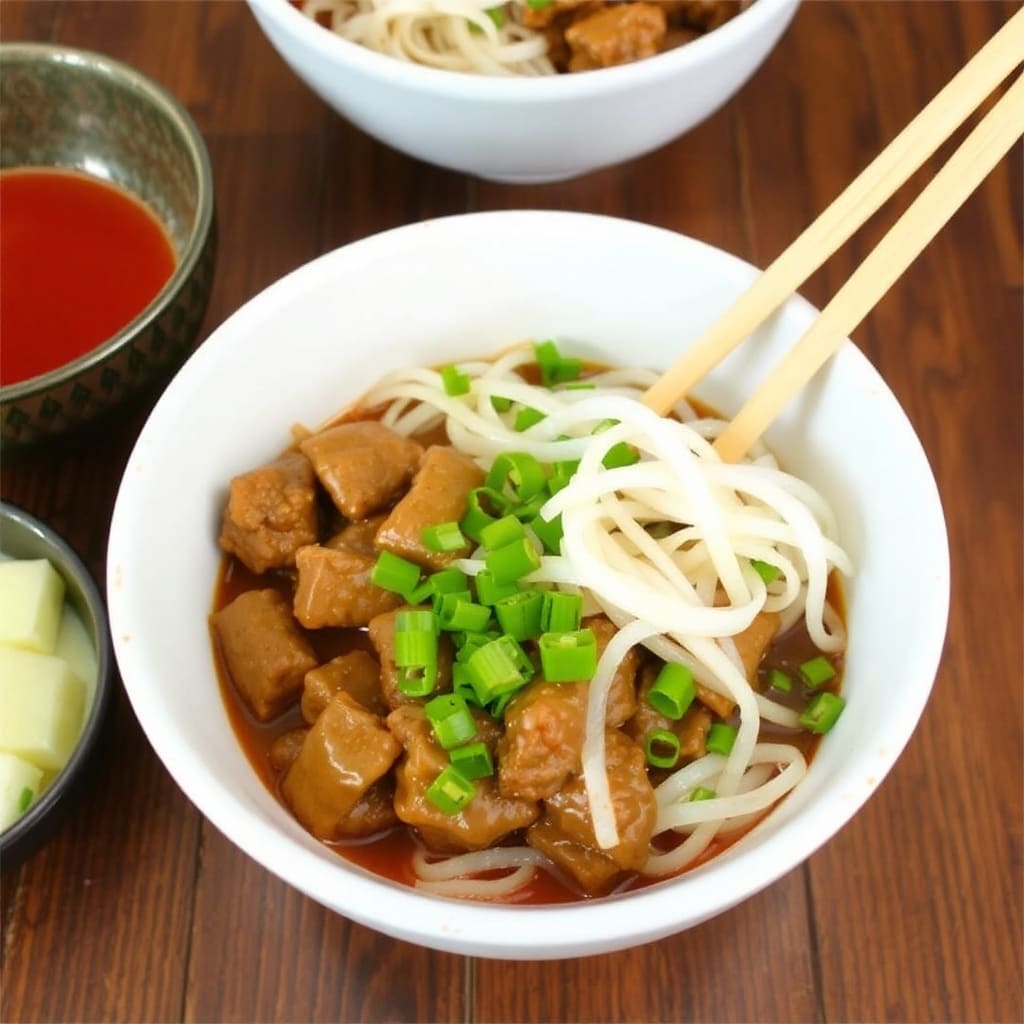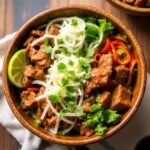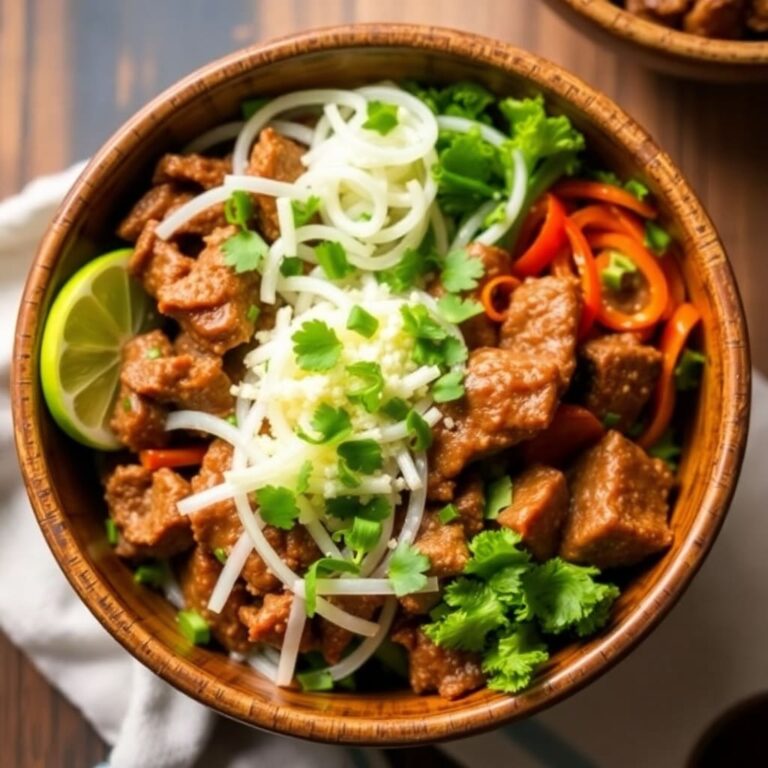Korean Beef Bowls are a culinary masterpiece that bring bold flavors and comforting textures to your table with minimal effort. Rooted in the vibrant cuisine of Korea, this dish perfectly balances sweet, savory, and spicy elements, making it a favorite for food lovers around the world.
What makes Korean Beef Bowls so special is their simplicity and versatility. With just a handful of staple ingredients like soy sauce, sesame oil, and gochujang, you can create a meal that’s bursting with authentic flavor. Whether you’re cooking for a busy weeknight dinner or impressing friends at a casual gathering, Korean Beef Bowls are quick to prepare and endlessly customizable.
In this blog, you’ll learn how to make authentic Korean Beef Bowls at home, discover tips for perfecting the recipe, and explore creative variations to suit your taste. Let’s dive in and bring the deliciousness of Korean cuisine to your kitchen!

What Are Korean Beef Bowls?
Korean beef bowls are a flavorful and convenient dish inspired by Korean cuisine, combining sweet, savory, and spicy elements into a single bowl. At their core, these bowls feature seasoned ground beef served over rice, topped with fresh vegetables and condiments.
For those unfamiliar with Korean cuisine, it is known for its bold flavors, unique ingredients, and a balance of sweet, sour, spicy, and umami. The inspiration for Korean beef bowls stems from traditional dishes like bulgogi, which uses marinated beef cooked to caramelized perfection.
These bowls are also influenced by the popular trend of rice bowls, which have gained global recognition for their versatility and convenience. Whether you’re a fan of authentic Korean flavors or seeking a quick and hearty meal, Korean beef bowls deliver on both fronts.
Origin of Korean Beef Bowls
Korean beef bowls draw inspiration from bulgogi, a classic Korean dish that translates to “fire meat.” Bulgogi traditionally features thinly sliced marinated beef grilled or stir-fried to achieve a caramelized, smoky flavor. While bulgogi requires marinating meat for several hours, Korean beef bowls offer a quicker alternative by using ground beef or pre-sliced cuts, allowing home cooks to replicate those signature flavors in a fraction of the time.
Key Features of Korean Beef Bowls
- Flavor Profile: The hallmark of Korean beef bowls lies in their harmonious blend of flavors. The beef is typically cooked with a combination of soy sauce, brown sugar, garlic, ginger, and sesame oil, creating a rich umami taste with hints of sweetness and nuttiness.
- Versatility: Korean beef bowls are highly customizable. Whether you prefer adding spicy gochujang (Korean chili paste), tangy pickled vegetables, or a soft-boiled egg, this dish can be tailored to suit your preferences.
- Nutritional Value: Packed with protein from the beef and fiber from the vegetables, Korean beef bowls are a wholesome, balanced meal that can be adjusted for various dietary needs.
These bowls bridge the gap between traditional Korean cuisine and the modern demand for quick, flavorful meals. Whether you’re a fan of Korean food or new to it, Korean beef bowls are an approachable and satisfying way to enjoy the rich culinary heritage of Korea.
Essential Ingredients for Authentic Korean Beef Bowls
Creating authentic Korean beef bowls at home requires a combination of core ingredients, flavorful toppings, and a perfect base. Each component contributes to the dish’s unique taste, texture, and visual appeal.

Core Ingredients
The foundation of a delicious Korean beef bowl lies in its carefully selected and prepared core ingredients:
- Ground Beef: Ground beef is the traditional choice, offering a tender and juicy texture that absorbs flavors beautifully. For variations, consider alternative proteins like ground chicken, turkey, or even tofu for a plant-based option.
- Sauce Components: The sauce is the soul of Korean beef bowls, delivering a perfect balance of sweet, savory, and umami flavors. Key ingredients include:
- Soy Sauce: Provides the salty and umami base.
- Brown Sugar: Adds sweetness to counterbalance the saltiness.
- Garlic: Enhances the overall depth of flavor.
- Ginger: Introduces a subtle spiciness and freshness.
- Sesame Oil: Offers a nutty aroma and richness, tying all the flavors together.
Optional Toppings for Flavor and Texture
Toppings are where you can get creative, adding layers of flavor, color, and texture to your Korean beef bowl:
- Kimchi: This fermented Korean staple adds a tangy, spicy kick that pairs perfectly with the savory beef.
- Pickled Vegetables: Thinly sliced radishes, carrots, or cucumbers pickled in vinegar provide a refreshing contrast.
- Green Onions: Chopped green onions offer a fresh, mild onion flavor and a pop of green.
- Sesame Seeds: Toasted sesame seeds contribute nuttiness and a delightful crunch.
- Fried Eggs: A sunny-side-up or soft-boiled egg adds creaminess and richness, elevating the bowl’s texture.
Each topping enhances the dish, creating a balanced bite that keeps the meal exciting. Mix and match toppings based on your taste preferences or what you have on hand.
Choosing the Right Rice Base
The base of your Korean beef bowl is just as important as the beef and toppings. It acts as the canvas, soaking up the flavorful juices and sauce. Here are some popular options:
- White Rice: The most traditional choice, offering a neutral flavor that highlights the boldness of the beef and sauce.
- Brown Rice: A nutty, fiber-rich option that adds a slightly chewy texture, perfect for a healthier twist.
- Cauliflower Rice: A low-carb alternative for those watching their calorie intake or following a keto-friendly diet.
Experiment with these bases to find the one that complements your meal and dietary needs. Whichever you choose, ensure it’s cooked to perfection to make your Korean beef bowl irresistibly satisfying.
Step-by-Step Guide to Making Korean Beef Bowls
Making Korean beef bowls at home is a simple and rewarding process. By following these steps, you’ll create a flavorful, balanced, and visually appealing dish.
Preparing the Ingredients
The key to a seamless cooking process is proper preparation:
- Prepping the Beef and Vegetables:
- Use fresh ground beef for the best flavor and texture. If frozen, make sure it’s fully thawed.
- Wash and slice any vegetables you plan to use as toppings, such as green onions, carrots, or cucumbers. For kimchi, ensure it’s drained if overly juicy to avoid making the bowl too wet.
- Mixing the Sauce:
- In a small bowl, whisk together your sauce ingredients: soy sauce, brown sugar, minced garlic, grated ginger, and sesame oil.
- Optional: Add a teaspoon of gochujang (Korean chili paste) or red pepper flakes if you prefer a spicier dish.
This step ensures everything is ready when you begin cooking, saving time and reducing stress.
Cooking the Korean Beef
Perfectly cooked beef is the heart of this dish, and attention to detail makes all the difference:
- Tips for Browning Ground Beef:
- Heat a large skillet over medium-high heat and add a small amount of oil.
- Break the beef into small pieces as it cooks, ensuring even browning. Drain excess fat for a leaner dish, if desired.
- Blending Flavors with the Sauce:
- Once the beef is browned, pour in the prepared sauce and stir to coat the meat thoroughly.
- Simmer for 2-3 minutes to allow the sauce to thicken and the beef to absorb the flavors.
- Optional: Sprinkle sesame seeds into the beef for added texture and nuttiness.
- Ensuring a Glossy Finish:
- Stir frequently as the sauce reduces. The goal is a glossy, slightly sticky coating that clings to the beef. Avoid overcooking to prevent the sugar in the sauce from burning.
How to Make Authentic Korean Beef Bowls at Home

Summary
This blog post provides a comprehensive guide on how to make authentic Korean beef bowls at home. It begins with an explanation of what Korean beef bowls are, tracing their roots to traditional Korean dishes like bulgogi, and highlighting their flavorful combination of sweet, savory, and spicy elements. The post details essential ingredients, including core components like soy sauce, sesame oil, and ground beef, as well as optional toppings for added flavor and texture.
Readers will find a step-by-step guide to preparing, cooking, and assembling the bowls, along with tips for balancing flavors, meal prepping, and customizing the dish for dietary preferences. Frequently asked questions are addressed, covering topics like spiciness adjustments, meal prep advice, and suggested side dishes.
The conclusion encourages readers to experiment with toppings, share their creations, and engage with the content by tagging their photos on social media. This blog is a must-read for anyone looking to enjoy a quick, versatile, and delicious homemade meal inspired by Korean cuisine.
Assembling the Bowl
Presentation and customization are what make Korean beef bowls both beautiful and fun to create:
- Layering the Components:
- Start with a generous scoop of rice (white, brown, or cauliflower) as the base.
- Add a layer of the cooked Korean beef on top of the rice.
- Arrange toppings such as sliced green onions, kimchi, pickled vegetables, or a fried egg around the beef for a visually appealing presentation.
- Customization Ideas:
- Create a spicy version by drizzling with sriracha or adding extra gochujang.
- Incorporate extra greens like spinach or lettuce for a fresh, crisp bite.
- Add avocado slices for creaminess or crushed nori sheets for a hint of seaweed flavor.
Encourage creativity in assembling bowls based on personal preferences, making each serving unique and delicious.
By following these steps, you’ll craft a perfectly balanced Korean beef bowl that’s as delightful to look at as it is to eat!
Tips and Tricks for Perfect Korean Beef Bowls
Creating the perfect Korean beef bowl is all about fine-tuning flavors, preparing efficiently, and adapting the dish to suit your dietary preferences. These tips will help you elevate your cooking and make the dish even more enjoyable.
Balancing Sweet and Savory Flavors
The hallmark of Korean beef bowls is their harmonious blend of sweet and savory flavors, with a hint of spice. Here’s how to perfect it:
- Adjusting Sugar:
- If the dish feels too salty, add a little more brown sugar or honey for a touch of sweetness. Conversely, reduce the sugar if you prefer a less sweet flavor.
- Enhancing Savory Notes:
- Add a splash of soy sauce if the dish needs more umami or saltiness. Low-sodium soy sauce is an option for controlling salt intake without losing flavor.
- Customizing Spice Levels:
- For a spicier kick, increase the amount of gochujang (Korean chili paste) or red pepper flakes. To tone it down, omit spicy ingredients altogether and let diners add heat to their bowls individually.
Finding the perfect balance ensures every bite is flavorful and satisfying.
Meal Prep and Storage Tips
Korean beef bowls are not only quick to make but also ideal for meal prepping. Here’s how to plan ahead and store them:
- How to Store Leftovers:
- Place leftover beef and rice in separate airtight containers to avoid sogginess.
- Store toppings like kimchi, green onions, and pickled vegetables separately to maintain their freshness.
- Reheating for Best Flavor:
- Reheat the beef in a skillet over medium heat, adding a splash of water or soy sauce to keep it moist.
- Warm the rice in the microwave or on the stovetop, covered, to prevent it from drying out.
- Making a Big Batch:
- Double the recipe to cook once and eat multiple times. Store pre-portioned bowls for easy grab-and-go meals throughout the week.
- Keep toppings fresh by prepping them in small amounts and replenishing as needed.
Meal prepping saves time and ensures you always have a delicious, homemade meal ready.
Substitutions for Dietary Preferences
Korean beef bowls are highly adaptable to suit various dietary needs:
- Low-Carb or Gluten-Free Adaptations:
- Swap the rice base for cauliflower rice or zucchini noodles for a low-carb option.
- Use tamari or coconut aminos instead of soy sauce to make the dish gluten-free.
- Plant-Based Protein Alternatives:
- Replace ground beef with crumbled tofu, tempeh, or plant-based ground meat for a vegetarian or vegan version.
- Season plant-based proteins with the same sauce to maintain the authentic Korean flavors.
These substitutions ensure that everyone, regardless of dietary preferences or restrictions, can enjoy this flavorful dish.
With these tips and tricks, your Korean beef bowls will be perfectly balanced, easy to prepare ahead of time, and adaptable for any diet. It’s all about making the dish your own while preserving its bold, delicious essence!
Frequently Asked Questions About Korean Beef Bowls
Whether you’re new to Korean beef bowls or a seasoned fan, you might have questions about making and customizing this dish. Here are answers to some common queries to help you master it.
Can I Make Korean Beef Bowls Ahead of Time?
Absolutely! Korean beef bowls are excellent for meal prepping, saving time and ensuring you have a delicious meal ready to go. Here are some practical tips:
- Prepare Components Separately:
- Cook the beef, rice, and toppings separately to maintain their freshness and texture. Store each component in airtight containers in the refrigerator.
- Portion for Convenience:
- Divide the beef and rice into individual servings, so they’re easy to grab and reheat. Keep toppings like kimchi, green onions, or fried eggs separate to add fresh before serving.
- Reheat Properly:
- When ready to eat, reheat the beef on the stovetop or microwave with a splash of water or soy sauce to keep it moist. Warm the rice separately and assemble the bowl just before serving.
Making Korean beef bowls ahead of time ensures you can enjoy their rich flavors without the hassle of daily cooking.
What Can I Serve with Korean Beef Bowls?
While Korean beef bowls are a complete meal on their own, pairing them with complementary side dishes can enhance your dining experience. Here are some popular options:
- Miso Soup: A light and savory soup that pairs well with the bold flavors of the beef.
- Korean Pancakes (Pajeon): These savory pancakes made with scallions or vegetables add a crispy texture to the meal.
- Fresh Salad: A simple green salad with sesame dressing or a cucumber salad balances the richness of the beef with freshness and crunch.
- Pickled Side Dishes (Banchan): Include small portions of pickled radishes, kimchi, or seasoned spinach to bring variety to the meal.
These sides not only complement the flavors of the beef bowl but also bring a traditional Korean touch to your table.
How Can I Adjust the Spiciness?
The spiciness of Korean beef bowls can be easily customized to suit your taste. Here’s how:
- Using Gochujang:
- Add a teaspoon or more of gochujang (Korean chili paste) to the sauce for a deeper, authentic spice. It also adds a touch of sweetness and umami.
- Incorporating Red Pepper Flakes:
- Sprinkle red pepper flakes into the sauce or as a garnish for a milder, adjustable heat level.
- Omitting Spice Entirely:
- If you prefer no heat, simply leave out spicy ingredients like gochujang or chili flakes. The dish will still be flavorful thanks to the sweet and savory sauce.
Spice can also be served on the side, allowing each diner to customize their bowl to their preferred heat level.
By addressing these common questions, you’ll be well-prepared to create, serve, and enjoy Korean beef bowls tailored to your taste and lifestyle!
Conclusion
Korean beef bowls are the perfect combination of ease, flavor, and versatility, making them a must-try dish for any home cook. With a balance of sweet, savory, and spicy flavors layered over a comforting base of rice and topped with fresh, vibrant ingredients, they’re a meal that delights both the palate and the eyes.
Whether you’re preparing them for a quick weeknight dinner, a meal prep solution, or a special family meal, Korean beef bowls are incredibly customizable. From experimenting with toppings like kimchi and fried eggs to trying alternative proteins or rice bases, the possibilities are endless.
Looking for more tips to elevate your cooking? Check out our Tips and Tricks for Perfect Korean Beef Bowls for advice on meal prep, balancing flavors, and dietary substitutions.
We encourage you to give this recipe a try and make it your own. Don’t forget to share your experience in the comments below—what toppings did you use? What variations did you try? We’d love to hear your feedback! If you’re feeling creative, snap a picture of your bowl creation and tag us on social media. Let’s inspire others to join the Korean beef bowl craze!





